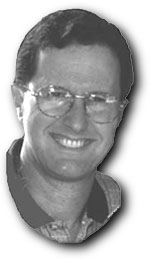
New Views of the Moon Enabled by Combined Remotely Sensed and Lunar Sample Data Sets
By Bradley L. Jolliff
Washington University, St. Louis
 | Announcing a CAPTEM Lunar Initiative: New Views of the Moon Enabled by Combined Remotely Sensed and Lunar Sample Data Sets
By Bradley L. Jolliff |
As preliminary results of the Lunar Prospector mission become available, and with the important results of the Galileo and Clementine missions now providing new global data sets of the Moon, it is imperative that we begin to synthesize these new data and integrate them with one another and with the lunar-sample data base. Toward this end, CAPTEM (Curation and Analysis Planning Team for Extraterrestrial Materials) has begun organizing a scientific initiative entitled "New Views of the Moon Enabled by Combined Remotely Sensed and Lunar Sample Data Sets."
In 1990 and 1992, the Galileo spacecraft encountered the Earth-Moon system and gave us new and astounding multispectral views of the Moon, which added significantly to the immense body of knowledge gained from Apollo-era studies and Earth-based telescopic studies (e.g., Pieters et al., 1993). Then, in 1994, the Clementine mission provided the first global or near-global data sets for lunar gravity, topography, and multispectral imaging. Early science results from the Clementine data have been nothing less than spectacular (summarized in McEwen and Robinson, 1997). These data sets will undoubtedly continue to provide a wealth of information for many years to come.
Numerous research groups have already begun to capitalize on the Clementine data sets and to integrate the new data with results from studies of rocks and soils collected during the Apollo missions, from studies of the geology of the landing sites, and from studies of the results of Apollo geophysical experiments. Even those of us who, to this point, have been primarily focused on the lunar samples, are beginning to recognize the importance and utility of the remotely-sensed data sets and the need to couple our understanding of the lunar samples with the wealth of information contained in the new data sets. Extending our understanding of lunar geology and resources from the landing-site scale to a truly global scale will provide the foundation for new paradigms of the Moon’s geologic evolution as well as a foundation for studies that pave the way to future resource utilization, on-surface experiments, and manned lunar-outpost missions.
A number of recent and ongoing efforts attempt to understand the remotely-sensed data in terms of lunar soil characteristics based both on laboratory studies (e.g., Fischer and Pieters, 1996, Taylor et al., 1997) and on calibration with soils and geology of the lunar landing sites (e.g., Blewett et al., 1997). Work of this kind is crucial to furthering our ability to extract the full measure of information from the new data sets. The purpose of this CAPTEM initiative is to facilitate interactions and intellectual cooperation between the lunar remote-sensing, geophysical, and sample communities, which will potentially lead to fundamentally new views of the Moon’s internal structure, surface geology, mare volcanism, and crustal and regolith evolution through time.
We will kick off the initiative at the 29th Lunar and Planetary Science Conference with a special topical session entitled "Probing the Moon with Remote Sensing and Samples: A New Integration." This is but the first of a number of topical or theme sessions that we plan to organize both for future LPSC’s and at other national meetings. We also plan to organize workshops where participants will discuss the new and existing data sets and how to use them, and will present new, integrated approaches to long-standing problems of lunar science and applications of multiple data sets to new problems. One of our long-term goals is to produce a volume similar to "Basaltic Volcanism on the Terrestrial Planets" (in quality, if not in vastness) toward the end of this initiative.
In the coming months, there will be many opportunities for the lunar geoscience community to participate in this exciting new initiative. We have organized a steering committee, consisting of individuals with expertise including lunar geology, remote sensing, geophysics, mineralogy, petrology, and geochemistry; and representing the breadth of current and coming data sets. We plan to establish a web site soon, so be on the lookout for additional information. In the meantime, your comments and suggestions are welcome; please send them to Brad Jolliff at blj@levee.wustl.edu.
References cited:
Pieters C., et al. (1993) Crustal diversity of the Moon: Compositional analyses of Galileo solid state imaging data. J. Geophys. Res. 98, 17,127–17,148.
McEwen A. S. and Robinson M. S. (1997) Mapping of the Moon by Clementine. Adv. Space Res. 19, 1523–1533.
Fischer E. M. and Pieters C. M. (1996) Composition and exposure age of the Apollo 16 Cayley and Descartes regions from Clementine data: Normalizing the optical effects of space weathering. J. Geophys. Res. 101, 2225–2234.
Taylor L. A., et al. (1997) Spectral reflectance versus abundances of minerals and glasses in the 10 to 45 micron size fraction of mare soil 12030. LPSC XXVIII, 1421–1422.
Blewett D. T., et al. (1997) Clementine images of the lunar sample-return stations: Refinement of FeO and TiO2 mapping techniques. J. Geophys. Res. 102, 16,319–16325.